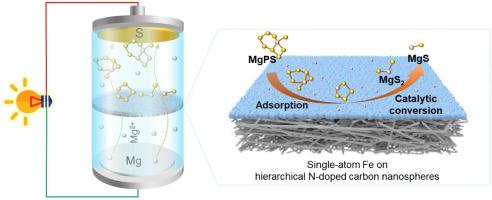Iron single atoms anchored on hierarchically porous carbon spheres as separator coating for high-performance magnesium-sulfur batteries
IF 14.3
1区 材料科学
Q1 MATERIALS SCIENCE, MULTIDISCIPLINARY
引用次数: 0
Abstract
Magnesium-sulfur (Mg–S) batteries have attracted increasing interest owing to their high theoretical energy density, intrinsic safety, and cost advantages. However, their practical deployment is hindered by several challenges, including the sluggish redox kinetics of sulfur species, severe polysulfide shuttle effects, and poor cycling stability. Herein, we report a separator modification strategy using single-atom iron anchored on hierarchically porous nitrogen-doped carbon nanospheres (Fe–NC) as a multifunctional interlayer. This Fe–NC coating functions both as a physical barrier to suppress polysulfide diffusion and as a catalytic interface offering abundant active sites for strong chemisorption and accelerated conversion of magnesium polysulfides (MgPSs), as evidenced by comprehensive structural, spectroscopic, and electrochemical analyses. Mg–S cells with Fe–NC-modified separators exhibit markedly enhanced electrochemical performance over those with pristine glass fiber (GF) separators, achieving an initial discharge capacity of 741 mAh g−1 at 0.1 C and maintaining 248 mAh g−1 after 150 cycles at 0.5 C. This work highlights the promise of atomic-level catalyst design for functional separator engineering toward high-performance Mg–S batteries.

铁单原子固定在分层多孔碳球上作为高性能镁硫电池的隔膜涂层
镁硫电池因其较高的理论能量密度、内在安全性和成本优势而受到越来越多的关注。然而,它们的实际应用受到一些挑战的阻碍,包括硫种氧化还原动力学缓慢,多硫穿梭效应严重,循环稳定性差。在此,我们报告了一种将单原子铁锚定在分层多孔氮掺杂碳纳米球(Fe-NC)上作为多功能中间层的分离器改性策略。综合结构、光谱和电化学分析证明,这种Fe-NC涂层既可以作为抑制多硫化物扩散的物理屏障,也可以作为催化界面,为强化学吸附和加速多硫化物(mgps)的转化提供丰富的活性位点。与原始玻璃纤维(GF)隔膜相比,fe - nc改性的Mg-S电池表现出明显增强的电化学性能,在0.1 C下达到741 mAh g−1的初始放电容量,在0.5 C下循环150次后保持248 mAh g−1。这项工作强调了原子级催化剂设计在高性能Mg-S电池功能分离器工程中的前景。
本文章由计算机程序翻译,如有差异,请以英文原文为准。
求助全文
约1分钟内获得全文
求助全文
来源期刊

Journal of Materials Science & Technology
工程技术-材料科学:综合
CiteScore
20.00
自引率
11.00%
发文量
995
审稿时长
13 days
期刊介绍:
Journal of Materials Science & Technology strives to promote global collaboration in the field of materials science and technology. It primarily publishes original research papers, invited review articles, letters, research notes, and summaries of scientific achievements. The journal covers a wide range of materials science and technology topics, including metallic materials, inorganic nonmetallic materials, and composite materials.
 求助内容:
求助内容: 应助结果提醒方式:
应助结果提醒方式:


